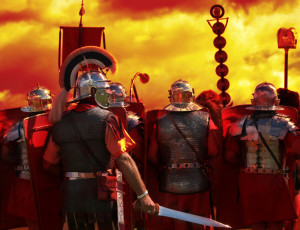 The world is a far more complex place than it was even just fifteen years ago. Today’s leaders need to manage many moving parts, contradictory information, connections which are often hard to see and senior managers who have conflicting interests.
The world is a far more complex place than it was even just fifteen years ago. Today’s leaders need to manage many moving parts, contradictory information, connections which are often hard to see and senior managers who have conflicting interests.
Many of us enjoy reading about history. I myself majored in modern and ancient history at university and continue to read books by good historians about many different periods of history. What has surprised me is how my hobby of reading history has given more depth to my work as a leadership development professional. Recently I have noticed how the study of history can help leaders think in more complex ways.
Stages of Adult Development
Over the last thirty years different thinkers have taken Jean Piaget’s theory of stages of development that children go through and built on it to apply to adults. They have observed that there are further stages of development that adults can choose to advance through. I say “choose” because unlike Piaget’s stages that children pass through automatically, each one allowing them to think in more complex ways, adults need to consciously work on advancing to higher level intellectual stages. The complexity that leaders have to manage today requires thinking from more advanced stages of development.
People like Robert Keegan, William Torbert, Nick Petrie, and Jennifer Garvey Berger, among many others, have carried out research on more advanced stages of intellectual development and described the type of thinking that is typical of superior stages. The point is that senior leaders need to continue to develop their thinking in order to arrive at these higher stages. But in order to advance to these stages, and thereby find new ways of thinking, they need to be aware of their existence and consciously work on advancing.
The advanced ways of thinking that you find in the higher stages, will help them lead in a far more complex world. This development has been called “Vertical Development”.
How to advance through Vertical Development
This begs the question, what can leaders do to advance to a higher stage of intellectual development and think differently? Over the next few weeks, I will explore different ways that leaders can develop vertically, for example, through understanding Systems Thinking or learning about a problem-solving methodology called Action Learning. Today however, I want to talk about the study of history and how it can help develop the type of thinking that exists in Keegan’s more advanced stages, the type of thinking that today’s executives need in order to lead in our complex world.
The Fall of Rome
Let us take for example, the Fall of the Roman Empire. We learnt at school that the end started when the emperor Valens took the radical decision to allow Goths to cross the Danube and settle in the Roman Empire in 376AD. This led directly, so we were taught, to the Goths rebelling and the sacking of Rome in 410AD. And so ,we had in our heads the image of bloodthirsty Germanic Barbarians, clad in furs with a knife in their mouth dripping with blood, intent of murder and pillaging. Indeed, this was the image we saw in the film Gladiator when the leader of a Germanic Tribe, with the head of a Roman Messenger in his hand, throws it to the ground in a violent gesture to reject negotiation. We were taught that the Empire came to an end due to a combination of an invasion of violent barbarians, completely foreign to the Roman World and corruption within the Empire. This presented us with a nice simple story. The reason for Rome’s fall was clear cut. But was it really so?
This explanation for the fall of Rome reflects the type of thinking described by Jennifer Garvey Berger as one of the five mind-traps that we fall into looking to simplify a complex world. An impossible task. She calls it the “Simple Stories Mind Trap”. This is one of five mind traps that Garvey Berger presents us with. Becoming conscious of these mind traps is one way of advancing to Keegan’s higher-level stages. This simple explanation for the fall of Rome makes us feel better, but it won’t lead us to a true insight into the real reason why such a powerful empire that gave so many people stability and peace over hundreds of years, ceased to exist.
To investigate more deeply will require a different type of thinking, an open mind to look at things differently, an inquisitive spirit to look for more variables, creativity to see how these variables interact with each other in novel ways, and an open heart to identify and question some of our own prejudices, values, and interpretations. As we will see later, this thinking will be even more effective if we do it with others, in a process of what Bill Torbert calls “collaborative inquiry”. Honestly trying to get close to the reality of what happened, we can achieve a deeper understanding of the meaning of many different events and how they interact with other events or actions. If we can do that, we will see a much richer and subtle picture and get a deeper understanding.
Factors that contributed to the fall of Rome
Firstly, the decision by Valens was not so radical, there had been many previous examples of peoples from outside of the empire being allowed to enter and settle within. All of these worked well. Secondly, these Goths had little to do with that image we see in Gladiator. Many were soldiers but they were also farmers and traders who had interacted with Roman officials for well over a hundred years. They spoke Latin and used Roman coin to trade. Many of them had served in the Roman army for decades, some arriving to very senior ranks. Their leaders wanted to live in brick houses with terracotta tiles and hot and cold running water, just like the Romans they admired. They drank wine, from fine ceramic cups and used olive oil, all imported from Roman provinces as far away as North Africa and Spain. These people did not want to destroy the Roman Empire, they want to be part of it.
The Gothic rebellion started because two corrupt officials who had been sent to administer the process of assimilation kept the funds and materials for themselves. However, these two officials were not entirely typical of provincial officials throughout the empire, many others administered honestly and fairly and achieved the collaboration of the locals. Even the Goth General who sacked Rome, Alaric, had not wanted to conquer Rome, rather he wanted to be given a senior command in the Roman army, and when this was refused by the child emperor, he sacked Rome, but, in a very orderly fashion with very little violence.
This whole situation would have been avoided if Flavius Stilicho, Regent to the child emperor Honorius, a Roman general and administrator of enormous talent, himself half Vandal, had not been executed by order of Honorius. The cause of Stilicho’s downfall was court intrigues by jealous Roman nobles who convinced Honorius that Stilicho was plotting to replace him with his own son, an accusation that was completely unfounded. The elimination of Stilicho directly led to Alaric’s success.
We therefore have another element to be considered when trying to understand the fall of the Roman Empire, namely the role of the nobles in the court of the emperor, their interests and their intrigues.
The more we study the late Roman empire the more we see the complexity of the situation. During the third century, after the reign of five extremely capable emperors terminating in Marcus Aurelius, the army, who got paid a special amount every time there was a new emperor, realised they had the power to appoint and depose emperors themselves. And every time they did, they got this special pay, called the “Donativium”. This led to an incredible turnover of emperors in the third century, some twenty in a period of fifty years. This caused countless civil wars, some more serious than others, but all weakening the empire. The empire recovered in the fourth century enjoying the reign of a number of extremely competent emperors like Constantine, Diocletian, and Theodosius, but usurpers and civil wars would continue to plague the empire.
The more we delve into the world of the late Roman empire the more variables we find. The abandonment of paganism and the adoption of Christianity as the state religion meant that the famous tolerance for different cultures, languages and religion drastically decreased. This tolerance was one of the glues that had held the empire together. The adoption of Christianity not only decreased tolerance of other culture’s religions, but also, the different schisms that existed in the early church proved to be a constant distraction for later emperors.
The great historian Edward Gibbons, one of the pioneers in the study of Roman History, exercised a huge influence on later scholars, through his work The Decline and Fall of the Roman Empire, first published in 1776. Gibbons put great emphasis on the adoption of Christianity as the main cause of the fall of Rome. It is interesting to note however that Gibbons was a famous anti cleric, and this prejudice led him to give a disproportionate view of the importance of Christianity’s role in the demise of the empire.
Another important factor was the debasement of the currency started by Nero, and continued by other emperors causing tremendous inflation that weakened the economy thereby reducing the amount of taxes collected which in turn cut funds to the army. Still another cause were the plagues, starting with the Antonine Plague, the Justinian Plague, the plague and the Cyprian, to name just three. Each plague decimated different parts of the empire, particularly afflicting the urban centres which were the beating heart of the empire. Reduced populations meant less taxes collected, less recruits for the army, less labour available for cultivation which in turn affected supplies and resources to the army.
Yet another cause was climate change which started during the first century, causing higher rainfall, negatively affecting agriculture which in turn reduced supply of grain to the army. Finally, the Diocletian reforms carried out by the very able emperor Diocletian in the late 290s AD, produced what could be described as the militarisation of the public administration. Up to then local nobles collected taxes for the emperor, kept some for themselves but also built public roads, bathhouses, arenas, theatres, aqueducts, and temples. This arrangement worked well and created goodwill between the provinces and Rome, whereas the army of public servants created a colder, more authoritarian relationship between the provinces and the central authority and chipped away at the loyalty of the provinces.
Academic Peer Review an example of Collaborative Inquiry
As you can see, the context in which the Roman Empire declined is enormously complex. There are so many elements that exercise influence. The relative importance of each of these elements and how they each interacted with each other, is subject of intense debate between extremely competent historians who dedicate their lives to this work. The best of them are open to questioning their own assumptions, they listen intensely to other historians’ perspectives and honestly try to look at the topic at hand through the perspective of their colleagues.
The truly great historians happily submit their papers for peer review showing their openness to have their assumptions, values and interpretations challenged by other learned colleagues. They welcome this as what they look for is to move ever closer to the truth in the topic they are dealing with. The willingness to submit yourself to peer review, either formally or informally though conversations, shows great maturity. It is an example of what Bill Torbert calls collaborative inquiry and is representative of the type of thinking you find in the higher stages of intellectual development.
If you want to have a deeper understanding of what really happened to Rome, you need to work hard, think deeply, be open minded, and look for things that others haven’t seen. You need to know your own values and prejudices and ask yourself if these are clouding your judgment. If they are, you need to have the ability and humility to revisit those values and prejudices. You need to be open to having your ideas challenged through robust and meaningful conversations with others. If you are capable of doing all of that, you may well come out of this process a slightly different person to the one that started. This is exactly what senior leaders need to do today.
For the amateur historian, the study of history, in itself a very enjoyable endeavour, is also a good example of vertical development. It is a way of developing your thinking and therefore, developing the type of leadership needed in today’s complex world.





No Comments so far ↓
There are no comments yet...Kick things off by filling out the form below.